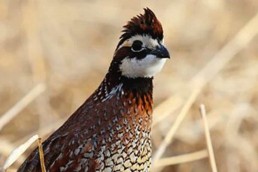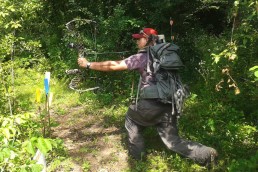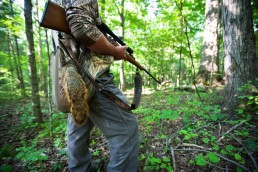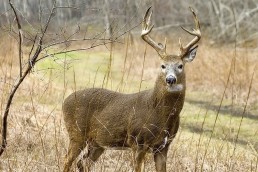Kentucky Rabbit and Quail Season at a Glance
SHARE THIS POST
Rural mail carriers that volunteer to help the Kentucky Department of Fish and Wildlife Resources reported seeing fewer rabbits along their routes this year, but hunters can still expect to encounter plenty of rabbits this season.
“If you look back at the data, we’ve had really high numbers of rabbits, some of the highest in several years,” said Ben Robinson, small game biologist with Kentucky Fish and Wildlife. “There should be good numbers of rabbits on the ground which should translate into good rabbit hunting.”
Kentucky’s rabbit and quail season dates vary by zone. The Eastern Zone is made up of 91 central and eastern Kentucky counties. In this zone, the season opened November 1 and continues through January 31.
The Western Zone includes Fulton, Hickman, Carlisle, Ballard, McCracken, Graves, Calloway, Marshall, Livingston, Lyon, Trigg, Caldwell, Crittenden, Christian, Hopkins, Webster, Union, Henderson, McLean, Muhlenberg, Todd, Logan, Simpson, Allen, Warren, Butler, Ohio, Daviess and Hancock counties. In those counties, the rabbit and quail season opened mid-November and runs through February 10. The statewide daily bag limit is four rabbits and eight quail.
“Rabbits do well in areas that are overgrown, grown-up fields and shrubby fencerows,” Robinson said. “And just because an area is grown up doesn’t mean that’s the first place you want to look for quail. They require more intensive management, which hopefully you’ll find on our public areas. One of the hot spots continues to be the multi-county Green River Conservation Reserve Enhancement Program (CREP) down around Mammoth Cave. We’re still getting good reports from there. It’s just a matter of figuring out ways to obtain landowner permission to hunt those properties.”
With the assistance from rural mail carriers and hunters, Kentucky Fish and Wildlife tracks hunter success and population trends on an annual basis. Hunters can help by keeping a daily hunting diary during the fall hunting seasons.
Printable logs are available online at fw.ky.gov or by contacting Kentucky Fish and Wildlife by phone at 800-858-1549, or by mail at 1 Sportsman’s Lane, Frankfort, KY 40601. Completed logs should be submitted at the end of the season. Hunters who cooperate will receive a small gift for their participation.
“It’s one of our primary surveys for monitoring population trends from year to year,” Robinson said. “In recent years, we’ve seen participation decline. We would love to have more hunters participate.”
Rabbit hunters who submitted hunter log surveys last season went on a combined 1,413 hunts in 93 counties, jumped an average of 6.5 rabbits per hunt and harvested an average of 2.7 rabbits per hunt. Quail hunters who completed hunting logs went on 365 hunts and reported flush and harvest rates almost double than that of the previous season.
Are you enjoying this post?
You can be among the first to get the latest info on where to go, what to use and how to use it!
The mail carrier survey offers a peek into what can be expected for the upcoming hunting season. Last year, the survey was conducted the last full week of July and indicated population declines in both species.
The timing of weather events can impact small game populations, and Kentucky experienced its share of extreme weather. In February and March last year, record cold, snow and flooding affected parts of the state. Then a hot and dry June was followed by a soggy July.
Biologists point to the cold and late snowfall as culprits contributing to the drop in the number of rabbits and quail observed by the mail carriers. Rabbits begin nesting in late February and their breeding season can continue into late summer. The peak hatch for quail occurred last July, so the heavy rain that month likely hurt chick survival in spots.
“I’m afraid I can’t give one statewide prediction for quail this year,” Robinson said. “From the anecdotal reports that I’m getting, it’s going to depend on where you are in the state. The fall covey counts conducted out west on Peabody Wildlife Management Area (WMA) were some of the best in recent years. You move into parts of central Kentucky and the numbers seem to be down. You keep going farther east and up to Clay WMA (in Nicholas, Fleming and Bath counties), and throughout the summer they were seeing broods all over the ground. It seems like kind of an odd year. It’s going to be hit or miss.”
The East Region from Lewis County down to Wayne County and points east led the state in the number of rabbits observed by mail carriers. The region also produced a year-over-year increase in the number of quail observed along delivery routes.
“We’ve always had good reports of rabbits and quail in that area,” Robinson said. “Some of the reclaimed mine areas are growing up. For the next couple of years, it may be an area that folks want to target if they can get access to some of these properties. If hunters are targeting those areas and can find food sources on those mine areas, there’s a good chance they’re going to find quail.”
Kevin Kelly is a staff writer for “Kentucky Afield” magazine and covers the state for MidWest Outdoors as well. Follow him on Twitter: @kyafield.
For more information about the rabbit, quail and other small game seasons, find the Kentucky Hunting and Trapping Guide, available online at fw.ky.gov and wherever hunting licenses are sold.
MWO
SHARE THIS POST
Did you enjoy this post?
You can be among the first to get the latest info on where to go, what to use and how to use it!
Kevin Kelly
Author Kevin Kelly is a staff writer for “Kentucky Afield” magazine, the official publication of the Kentucky Department of Fish and Wildlife Resources. Get the latest from Kelly and the entire “Kentucky Afield” staff by following them on Twitter @kyafield.



